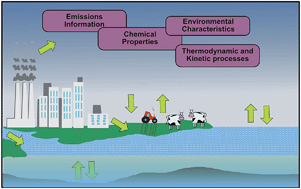当前位置:
X-MOL 学术
›
Environ. Sci.: Processes Impacts
›
论文详情
Our official English website, www.x-mol.net, welcomes your
feedback! (Note: you will need to create a separate account there.)
Environmental fate and exposure models: advances and challenges in 21st century chemical risk assessment
Environmental Science: Processes & Impacts ( IF 4.3 ) Pub Date : 2017-12-20 00:00:00 , DOI: 10.1039/c7em00568g Antonio Di Guardo 1, 2, 3, 4 , Todd Gouin 5, 6 , Matthew MacLeod 7, 8, 9, 10 , Martin Scheringer 11, 12, 13, 14, 15
Environmental Science: Processes & Impacts ( IF 4.3 ) Pub Date : 2017-12-20 00:00:00 , DOI: 10.1039/c7em00568g Antonio Di Guardo 1, 2, 3, 4 , Todd Gouin 5, 6 , Matthew MacLeod 7, 8, 9, 10 , Martin Scheringer 11, 12, 13, 14, 15
Affiliation

|
Environmental fate and exposure models are a powerful means to integrate information on chemicals, their partitioning and degradation behaviour, the environmental scenario and the emissions in order to compile a picture of chemical distribution and fluxes in the multimedia environment. A 1995 pioneering book, resulting from a series of workshops among model developers and users, reported the main advantages and identified needs for research in the field of multimedia fate models. Considerable efforts were devoted to their improvement in the past 25 years and many aspects were refined; notably the inclusion of nanomaterials among the modelled substances, the development of models at different spatial and temporal scales, the estimation of chemical properties and emission data, the incorporation of additional environmental media and processes, the integration of sensitivity and uncertainty analysis in the simulations. However, some challenging issues remain and require research efforts and attention: the need of methods to estimate partition coefficients for polar and ionizable chemical in the environment, a better description of bioavailability in different environments as well as the requirement of injecting more ecological realism in exposure predictions to account for the diversity of ecosystem structures and functions in risk assessment. Finally, to transfer new scientific developments into the realm of regulatory risk assessment, we propose the formation of expert groups that compare, discuss and recommend model modifications and updates and help develop practical tools for risk assessment.
中文翻译:

环境归宿和曝光模式:在21进和挑战ST世纪化学品风险评估
环境归宿和暴露模型是一种强大的手段,可以整合有关化学物质,其分配和降解行为,环境情景和排放的信息,以编制多媒体环境中化学物质分布和通量的图。在模型开发者和用户之间举行的一系列研讨会中,一本1995年的开创性著作报道了多媒体命运模型领域的主要优势和确定的研究需求。在过去的25年中,人们为改善这些问题做出了巨大的努力,并且在许多方面进行了完善。特别是在建模物质中包括纳米材料,在不同时空尺度上开发模型,化学性质和排放数据的估算,其他环境介质和工艺的纳入,仿真中灵敏度和不确定性分析的集成。但是,仍然存在一些具有挑战性的问题,需要进行研究和关注:需要一种方法来估计环境中极性和可电离化学物质的分配系数,需要更好地描述不同环境中的生物利用度,以及在暴露时注入更多生态现实主义的要求。在风险评估中考虑生态系统结构和功能多样性的预测。最后,为了将新的科学发展转移到监管风险评估领域,我们建议组建专家组,以比较,讨论和推荐模型修改和更新,并帮助开发用于风险评估的实用工具。仍然存在一些具有挑战性的问题,需要进行研究和关注:需要一种方法来估计环境中极性和可电离化学物质的分配系数,需要更好地描述不同环境中的生物利用度,并且需要在暴露预测中注入更多的生态现实主义。在风险评估中说明了生态系统结构和功能的多样性。最后,为了将新的科学发展转移到监管风险评估领域,我们建议组建专家组,以比较,讨论和推荐模型修改和更新,并帮助开发用于风险评估的实用工具。仍然存在一些具有挑战性的问题,需要进行研究和关注:需要一种方法来估计环境中极性和可离子化化学物质的分配系数,需要更好地描述不同环境中的生物利用度,并且需要在暴露预测中注入更多的生态现实主义在风险评估中说明了生态系统结构和功能的多样性。最后,为了将新的科学发展转移到监管风险评估领域,我们建议组建专家组,以比较,讨论和推荐模型修改和更新,并帮助开发用于风险评估的实用工具。更好地描述了不同环境中的生物利用度,以及在暴露预测中注入更多生态现实主义的要求,以说明生态系统结构和功能在风险评估中的多样性。最后,为了将新的科学发展转移到监管风险评估领域,我们建议组建专家组,以比较,讨论和推荐模型修改和更新,并帮助开发用于风险评估的实用工具。更好地描述了不同环境中的生物利用度,以及在暴露预测中注入更多生态现实主义的要求,以说明生态系统结构和功能在风险评估中的多样性。最后,为了将新的科学发展转移到监管风险评估领域,我们建议组建专家组,以比较,讨论和推荐模型修改和更新,并帮助开发用于风险评估的实用工具。
更新日期:2017-12-20
中文翻译:

环境归宿和曝光模式:在21进和挑战ST世纪化学品风险评估
环境归宿和暴露模型是一种强大的手段,可以整合有关化学物质,其分配和降解行为,环境情景和排放的信息,以编制多媒体环境中化学物质分布和通量的图。在模型开发者和用户之间举行的一系列研讨会中,一本1995年的开创性著作报道了多媒体命运模型领域的主要优势和确定的研究需求。在过去的25年中,人们为改善这些问题做出了巨大的努力,并且在许多方面进行了完善。特别是在建模物质中包括纳米材料,在不同时空尺度上开发模型,化学性质和排放数据的估算,其他环境介质和工艺的纳入,仿真中灵敏度和不确定性分析的集成。但是,仍然存在一些具有挑战性的问题,需要进行研究和关注:需要一种方法来估计环境中极性和可电离化学物质的分配系数,需要更好地描述不同环境中的生物利用度,以及在暴露时注入更多生态现实主义的要求。在风险评估中考虑生态系统结构和功能多样性的预测。最后,为了将新的科学发展转移到监管风险评估领域,我们建议组建专家组,以比较,讨论和推荐模型修改和更新,并帮助开发用于风险评估的实用工具。仍然存在一些具有挑战性的问题,需要进行研究和关注:需要一种方法来估计环境中极性和可电离化学物质的分配系数,需要更好地描述不同环境中的生物利用度,并且需要在暴露预测中注入更多的生态现实主义。在风险评估中说明了生态系统结构和功能的多样性。最后,为了将新的科学发展转移到监管风险评估领域,我们建议组建专家组,以比较,讨论和推荐模型修改和更新,并帮助开发用于风险评估的实用工具。仍然存在一些具有挑战性的问题,需要进行研究和关注:需要一种方法来估计环境中极性和可离子化化学物质的分配系数,需要更好地描述不同环境中的生物利用度,并且需要在暴露预测中注入更多的生态现实主义在风险评估中说明了生态系统结构和功能的多样性。最后,为了将新的科学发展转移到监管风险评估领域,我们建议组建专家组,以比较,讨论和推荐模型修改和更新,并帮助开发用于风险评估的实用工具。更好地描述了不同环境中的生物利用度,以及在暴露预测中注入更多生态现实主义的要求,以说明生态系统结构和功能在风险评估中的多样性。最后,为了将新的科学发展转移到监管风险评估领域,我们建议组建专家组,以比较,讨论和推荐模型修改和更新,并帮助开发用于风险评估的实用工具。更好地描述了不同环境中的生物利用度,以及在暴露预测中注入更多生态现实主义的要求,以说明生态系统结构和功能在风险评估中的多样性。最后,为了将新的科学发展转移到监管风险评估领域,我们建议组建专家组,以比较,讨论和推荐模型修改和更新,并帮助开发用于风险评估的实用工具。











































 京公网安备 11010802027423号
京公网安备 11010802027423号